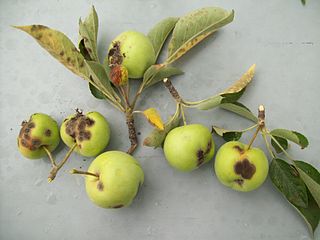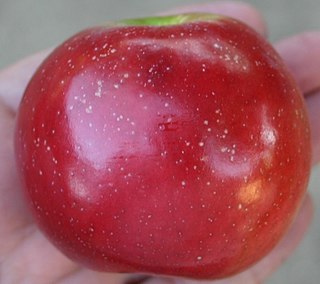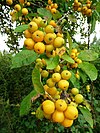Related Research Articles

The McIntosh, McIntosh Red, or colloquially the Mac, is an apple cultivar, the national apple of Canada. The fruit has red and green skin, a tart flavour, and tender white flesh, which ripens in late September. In the 20th century, it was the most popular cultivar in Eastern Canada and New England, and is considered an all-purpose apple, suitable both for cooking and eating raw.

Malus is a genus of about 30–55 species of small deciduous trees or shrubs in the family Rosaceae, including the domesticated orchard apple, crab apples and wild apples.

Apple scab is a common disease of plants in the rose family (Rosaceae) that is caused by the ascomycete fungus Venturia inaequalis. While this disease affects several plant genera, including Sorbus, Cotoneaster, and Pyrus, it is most commonly associated with the infection of Malus trees, including species of flowering crabapple, as well as cultivated apple. The first symptoms of this disease are found in the foliage, blossoms, and developing fruits of affected trees, which develop dark, irregularly-shaped lesions upon infection. Although apple scab rarely kills its host, infection typically leads to fruit deformation and premature leaf and fruit drop, which enhance the susceptibility of the host plant to abiotic stress and secondary infection. The reduction of fruit quality and yield may result in crop losses of up to 70%, posing a significant threat to the profitability of apple producers. To reduce scab-related yield losses, growers often combine preventive practices, including sanitation and resistance breeding, with reactive measures, such as targeted fungicide or biocontrol treatments, to prevent the incidence and spread of apple scab in their crops.

The 'Pink Pearl' apple is a pink-fleshed apple cultivar developed in 1944 by Albert Etter, a northern California breeder. It is a seedling of 'Surprise', another pink-fleshed apple that is believed to be a descendant of Malus niedzwetskyana.

Venturia inaequalis is an ascomycete fungus that causes the apple scab disease.

Esopus Spitzenburg or Aesopus Spitzenburgh is a variety of apple. It was discovered early in the 18th century near Esopus, Hudson, New York and is reputed to have been a favorite apple of Thomas Jefferson, who planted several of the trees at Monticello.

Malus floribunda, common name Japanese flowering crabapple, Japanese crab, purple chokeberry, or showy crabapple, originates from Japan and East Asia. It may be a hybrid of M. toringo with M. baccata, in which case it would be written as Malus × floribunda.

Claygate Pearmain is an apple cultivar. It was found at Claygate, Surrey in England and brought to the attention of the Royal Horticultural Society by John Braddick in 1821. The apple was a popular eating apple in Victorian times and spread through England and to America.

An apple is a round, edible fruit produced by an apple tree. Apple trees are cultivated worldwide and are the most widely grown species in the genus Malus. The tree originated in Central Asia, where its wild ancestor, Malus sieversii, is still found. Apples have been grown for thousands of years in Asia and Europe and were introduced to North America by European colonists. Apples have religious and mythological significance in many cultures, including Norse, Greek, and European Christian tradition.

Malus baccata is an Asian species of apple known by the common names Siberian crab apple, Siberian crab, Manchurian crab apple and Chinese crab apple. It is native to many parts of Asia, but is also grown elsewhere as an ornamental tree and for rootstock. It is used for bonsai. It bears plentiful, fragrant, white flowers and edible red to yellow fruit of about 1 cm diameter.
Niels Ebbesen Hansen was a Danish-American horticulturist, botanist, and agricultural explorer for the United States Department of Agriculture and the state of South Dakota. He searched the harsh environments of northern Scandinavia, Siberia, Manchuria, and the dry steppes of the Volga for plant stock that could flourish on the upper Great Plains.

Malus niedzwetzkyana, or Niedzwetzky's apple, is a kind of apple native to certain parts of China, Afghanistan, Kazakhstan, Kyrgyzstan, and Uzbekistan noted for its red-fleshed, red-skinned fruit and red flowers. Some botanists consider it a distinct species, while others have argued it is simply an unusual variety of the common apple, Malus pumila.

'Surprise' is a pink-fleshed apple that is the ancestor of many of the present-day pink/red-fleshed apples bred by American growers.

Pristine apple is a hybrid cultivar of 'Co Op 10' x 'Camuzat' domesticated apples, which are descendants of the 'McIntosh' apple and the 'Starking Delicious'. This cultivar was developed and patented in the United States by the PRI disease resistant apple breeding program, in Indiana, United States in 1994, for its resistance to apple scab. It is susceptible to cedar-apple rust.

Malus PERPETU 'Evereste' is an ornamental cultivar of crabapple that was developed by INRA in 1974 and is registered under their trademark with the name Malus perpetu.
The PRI disease resistant apple breeding program is a joint project of the Purdue University, Rutgers University, and the University of Illinois, to breed apple cultivars to be resistant to apple scab. The initialism stands for the three involved universities: Purdue, Rutgers and Illinois.

'Ariane' is a modern cultivar of domesticated apple that was recently developed in France for scab resistance.

Red Astrachan is a Russian or Swedish cultivar of domesticated apple, which is an early season apple, juicy, tart and mealy texture with pleasant flavour, and use for eating, cooking and cider. It is medium-sized, crimson colored. As all the early season apples, it is not good for storage. It is known by several other names including 'Abe Lincoln', 'American Red', and 'Waterloo'.

Enterprise is a modern bred, late-ripening and attractive, red cultivar of domesticated apple with excellent fruit quality combined with disease resistance to scab, cedar apple rust, fire blight and some resistance to powdery mildew. The fruit is large and attractive and retains excellent fresh quality for up to six months at 1°C. Its moderate acidity at time of harvest mellows in storage, and it is best after one month of storage.

The 'Prima' apple is one of the modern disease resistant cultivars of domesticated apple which was bred by the PRI disease resistant apple breeding program in 1958. The disease resistance against apple scab has since been broken.
References
- 1 2 3 4 Roger Vick (1991). Edible Apples to 1990: as grown in the Canadian Prairie Provinces (PDF). University of Alberta Devonian Botanic Garden.
- ↑ Wesley Autio and James Krupa (2002). "Performance of the V Series Apple Rootstocks During Six Growing Seasons". Fruit Notes. 67 (Summer).
- ↑ W. D. Evans and R. J. Hilton (1957). "Methods Of Evaluating Stock/Scion Compatibility In Apple Trees". Canadian Journal of Plant Science. 37 (4): 327–336. doi:10.4141/cjps57-038.
- ↑ R. E. Harris (1974). "Apple-crab "Trailman". Canadian Journal of Plant Science. 54: 105. doi:10.4141/cjps74-017.
- ↑ "Vf scab resistance of Malus". Archived from the original on 2014-12-19. Retrieved 2014-12-19.
- ↑ "The Ettersburg Apple Legacies", Greenmantle Nursery website
- ↑ "Rosé Ciders to Try This Summer" [ permanent dead link ]
